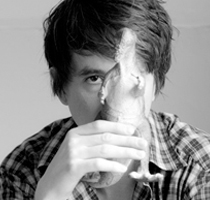First, a slight pause to really commend Johnstone’s sonic adeptness, his masterful playing of assonance, rhyme, and alliteration. For the sake of example, I’ll take a look at the second poem in the collection, “Lazarus Among the Hounds.†The poem begins by grounding the reader in song: “Nothing I can tell you will free/ your hands from their progression –/ Em7, Am7, B7,// a-qui se que-da la cla-ra.†I’ll quote the poem now at some length to properly convey its tonal variation:
the inflection of my a’s slurred
from the cave of a microphone.
At the leftover chords, dogs
think of nothing but food,
their amygdalae’s blazing
with crude spurs, neighbouring
cells demanding more. More
of what is what I’d like
to know, the mutts gathered
with sunset at four-paned
dining hall windows.
It might be labourious to track all the slant rhymes and rhythms at work here, so let’s just look at a few. The slurred “aâ€in the first line syncs up with “cave†(and perhaps the following “a†as well). “Leftover†carries the sound of the o’sfrom “microphone,†morphing slightly to “chords.†The ae of “amygdalae†repeats in “blazing†and “neighbouring,†while the oo of “food†recurs in “crude†and “to.†“What†matches up with “mutts,†“more†rhymes with “four,†the “I’d†echoes faintly in “dining,†and “know†returns to haunt “windows.†Watch the build-up of words containing w: what and what and know and windows. Nothing here seems forced or over-wrought. Johnstone simply does not miss opportunities to drive home his music, to exploit each vowel’s potential to ring and electrify its neighbours. Now, the relentless science-infused language can have its tiring snags, and some lines read as somewhat overblown (Citizen Kane’s sled is his “Blessed conduit of salvation,†for example). But the music of Patternicity is one of its most striking, commendable aspects; it’s a book brimming with poems as much for the ear as any other sense.
But it’s sense that requires a more dexterous form of tackling. Part of my understanding of Patternicity began with a read of Michael Sherman’s article of the same name, published in 2008 in Scientific American. To paraphrase grossly, “patternicity†is our tendency to see patterns in chaotic phenomena. We see a burnt piece of toast and see the face of Christ; we see a shadow on the wall and assume it’s a ghost. Identifying causal associations has always been essential to our survival (e.g., I put my toe in the fire, I get burnt; fire is dangerous!), but apparently our ability to see patterns is so essential to the continuation of our species that jumping to conclusions is hard-wired into our makeup. Patternicity boils down to an equation provided by Johnstone in the first poem of the book, also called “Patternicityâ€: “pb > c,†or the probability that one will benefit from recognizing a causal association will outweigh the cost required of its belief. Our tendency to be superstitious and habitual is written into the code of natural selection; it’s a genetic strategy for survival, even if our imagined miracles and apparitions bear no resemblance to reality.
What is this process of making connections—fusing like and unlike, seeing order in chaos—but a basic form of metaphor-making? “Patternicity†proves that the metaphorical urge is more than a means of expression or a flight of fancy, but an evolutionary need. Perhaps poetry endures because it maintains a sense of mystery in a world of banished superstition. Perhaps poetry is a genetic expression, a survival mechanism, where other forms of evolutionary selection have been made irrelevant. Perhaps poetry endures simply for its primal connection with our ancestral brain, stored deep in the roots of our grey matter. Who knows? By simply imposing order where chaos reigns, poetry remains (at least) as our “momentary stay against confusion,†and a potential bridge between the arts and her long-estranged sister, science.





No Comments so far ↓
There are no comments yet...Kick things off by filling out the form below.